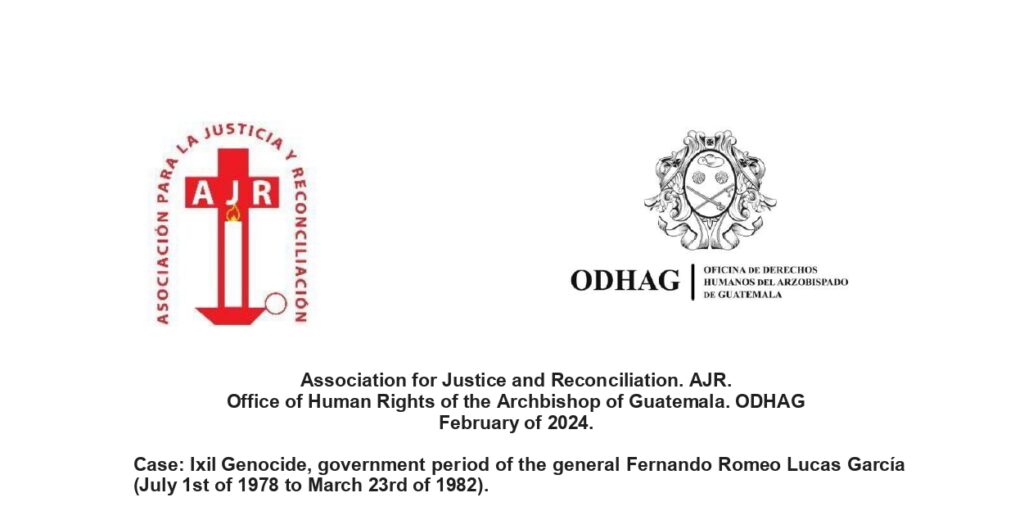
Background.
After 36 years, Guatemala put an end to the Internal Armed Conflict –IAC-, with the definitive ceasefire and the signing of the firm and lasting Peace Agreement on December 29th of 1996.
Previously, through the Oslo Accords (1994), the parties agreed to the creation of the Commission for Historical Clarification (CEH) with the purpose of “clarifying with complete objectivity, fairness and impartiality the violations of Human Rights and the acts of violence that caused suffering to the Guatemalan population, linked to the armed conflict,” however the Commission would have an extendable term of 6 months of work from its installation, which would occur between 1997 and 1998.
The same year of 1994, worried about the little time the CEH would have to investigate what had occurred during 36 years of conflict, and the conditions of fear and military control which the population was submitted to to be able to give their testimony, Bishop Juan José Gerardi Conedera prompted the creation and realization of the Interdiocesan Project of Recuperation of Historical Memory –REMHI- from the Office of Human Rights of the Archbishop of Guatemala, as a first effort of investigation for the clarification of the truth, cemented in the infrastructure of the church, and help to prepare the material conditions, spiritual and of trust in the people and communities so that the national and international team of the UN (United Nations) which made up the CEH could work and elaborate its final report.
The REMHI presented its report Guatemala: Never Again, on April 24th of 1998. The CEH, the report Guatemala: Memories of Silence, on February 25th of 1999.
The CEH established, -as results of the investigations of the REMHI, other sources (1) and its own investigation-, that during the Internal Armed Conflict, especially between 1978 and 1996, approximately 160,000 arbitrary execution and 40,000 forced disappearances were committed, which allowed it to establish an approximation of 200,000 direct victims (2), without establishing precisely the number of deaths occurred during the forced displacement in the mountains due to bombardments, hunger, thirst, illnesses and lack of medications.
As a result of such operations, the CEH registered a total of 415 massacres committed between June of 1981 and December of 1982, consolidating 64% of the total of the massacres committed by State security forces (626) and 76% of the total of victims of arbitrary executions registered. The largest number of cases are concentrated in the Departments of Quiché and Huehuetenango with 344 and 89 massacres respectively, adding up to an estimate of 5,591 direct victims.
The case:
In 2008, the ODHAG accepted the request of the Association for Justice and Reconciliation -AJR-, (3) to direct the investigation and the legal action in a criminal complaint against the Military High Command of former General Romeo Lucas García, for grave human rights violation committed by the State security forces against the Maya Ixil (4) ethnic group between July 1st of 1978 and March 23rd of 1982.
Between 2008 and 2019, preliminary investigation work was carried out, identifying a series of serious acts committed by elements of the Guatemalan Army in at least 22 communities of the municipalities of Santa María Nebaj, San Gaspar Chajul and San Juan Cotzal and approximately 265 witnesses (91 men and 174 women) were identified, belonging to the Ixil, Kiché and Kanjob’al peoples. direct survivors of the events.
In light of the work carried out by the REMHI project and the information in its database, as well as the information contained in the report of the Commission for Historical Clarification (CEH), the veracity and coherence of the testimonies collected was corroborated, the documented facts were classified and, in coordination with the Human Rights Prosecutor’s Office of the Public Prosecutor’s Office, testimonies were taken documenting selective repression against Indigenous spiritual guides and members of Catholic Action, members of cooperatives, catechists, priests and peasant leaders in the first phase (1978-1989), testimonies were taken that document the selective repression against indigenous spiritual guides and members of Catholic Action, members of cooperatives, catechists, priests and peasant leaders in the first phase (1978-1981) and the indiscriminate and massive repression against entire Mayan communities including children, elderly and pregnant women and the destruction of villages and vast community territories (1981-1982).
The general data extracted in the research stage caused the registration of a minimum of 1296 victims (nominal and non-nominal) in the context of:
- 34 Massacres (Cause death to more than 3 people in one same event).
- Extrajudicial executions.
- 49 events of submitting the population to Forced Displacement, persecution, bombardment, hunger, thirst and illnesses through destruction of means of subsistence in the mountains, which brought the death of members of the group.
- 23 events of burning, destruction, robbing and sacking of houses, harvests, work tools and belongings.
44 events of:
- Forced Disappearance. 30 events of:
- Sexual Violence.
To strengthen the testimonial evidence, 148 forensic anthropology expert reports were collected, previously carried out by the exhumation teams of the ODHAG, the Guatemalan Forensic Anthropology Foundation (FAFG) and the Center of Forensic Analysis and Applied Sciences (CAFCA), which constitute the scientific evidence that proves the veracity of the testimonies, the existence of the victims, the violence used against them, the conditions surrounding their death, the type of weapons used and the way in which they were killed. The expert reports also demonstrate that the victims were not killed in combat actions, that many of them were immobilized before being killed, that the vast majority were children, young people, the elderly and pregnant women, and that there is evidence of the viciousness with which the remains were attacked, mutilated and burned. Ballistic expert reports were also prepared by the National Institute of Forensic Sciences (INACIF), on the remains of ballistic material for military use found in the exhumed graves.
Fourteen general expert opinions were prepared by an equal number of national and international experts in different branches of science, who contributed scientific, theoretical, practical, historical, legal, anthropological, sociological, psychological, mathematical and jurisprudential elements for the analysis of the facts, the crimes and offenses, the culture, the protected group, the historical context, the modus operandi of the perpetrators, the violence perpetrated, the physical, material and mental damage caused to the victims and survivors, international humanitarian law and the effects and consequences of the violence, among many other aspects.
Approximately 40 documents of the Guatemalan Army, newspaper records, declassified documents from the United States State Department, independent, national and international reports of investigations of human rights violations, as well as documents of individualization of possible perpetrators of the events were collected and obtained under court order, through which plans and orders issued by the General Staff of the Guatemalan Army (EMGE) to carry out counterinsurgency operations in the Ixil Region and which caused serious violations were identified during the time of our investigation; Appointments of General Officers, Superior and subordinate officers who commanded the military units that executed the operations orders; an EMGE Intelligence Analysis that qualifies the Ixil population as an internal enemy of the State, U.S. State Department reports that recorded the orders to raze villages and livelihoods of the population, a Civil Affairs Plan which reinforces the qualification of the Ixil people as an internal enemy and designs military strategies and tactics that, when applied, caused serious damage to the life, community, culture and future of the victims.
In addition, material evidence was collected from the clandestine graves, such as skeletons, remains of the victims’ clothes and personal belongings, such as identity cards, and ballistic material used by the perpetrators. Also photographs and audiovisual material taken by national and international journalists in the context and place where the events occurred.
The means of investigation that have been presented to initiate the oral and public trial phase are as follows:

All the evidence gathered, the systematization and processing of the information allowed to establish that the Military High Command ordered, -in accordance with the Counter-Subversive Doctrine in force at the time, the information and conclusions presented by the Second Section (intelligence) of the EMGE on the scenarios and supposed threats detected and the information and conclusions presented by the Third Section (operations) on the state of force, the firepower, the maneuver capacity and the courses of action to be taken by the military units and troops to eliminate such threats- the national strategic planning at the level of the EMGE (and its sections or directorates of Personnel (S-1), Intelligence (S-2), Operations (S-3) and Staff (S-4)), the Tactical-Operational Planning at the regional and local levels, and the implementation of military operations aimed at neutralizing or eliminating the internal enemy and threats, in accordance with the courses of action chosen at the stragegic level (5).
Thus, in military phases duly established (6) as Prevention Phase, Intervention Phase and Consolidation Phase, the actions of the High Command of the Guatemalan Army (composed of the President of the Republic -7- , the Minister of Defense -8- and the Chief of the EMGE -9-), of the military operations of the General Staff Officers as chiefs of the EMGE Sections at the strategic level, and the Brigade Commanders, military Zones with jurisdiction over the 3 municipalities of the Ixil Region and their Detachments, at their respective levels, launched military operations with different degrees of scope, complexity and force that evidenced staggered and logical levels (from the military point of view) of violence that resulted, first in selective death, multiple and serious violations of the Human Rights of the non-combatant civilian population, and later the massive, systematic and generalized death followed by persecution, with the intention of eliminating the Ixil Mayan ethnic group, identified as an internal enemy and geographically located in the municipalities of Santa María Nebaj, San Juan Cotzal and San Gaspar Chajul.
From a factual point of view, the Prevention Phase in the Ixil Region was implemented between 1978 and December of 1981. It consisted of the implementation of operations for the control of the population and its resources, intelligence operations against local, indigenous and peasant leaders to identify the supposed Local Political Administrative Organization of the enemy and proceed to eliminate it, registering at least:
- 65 events cataloged as Attempts on life, among those 14 massacres of selective character against local leaders, spiritual guides and members of Catholic Action, as well as against select groups of people, and,
- 12 events of Sexual Violence.
All classified as Crimes Against the Duties of Humanity.
The intervention phase was implemented from the beginning of January until March 23, 1982 and consisted of concentrated efforts, abundant resources and numerous personnel to launch intense military operations of destruction and expulsion, operations to control the population and to organize it against the subversive movement, which caused at a minimum:
- Death of members of the group, in 20 widespread, indiscriminate and massive massacres against civilian population.
- Injuries that seriously affected the physical and mental integrity of members of the group, including 17 acts of Sexual Violence:
- Subjection of members of the group to conditions of existence that caused their total or partial destruction, among these, 23 villages razed, robbery, looting and destruction and 49 facts of persecution, bombing, subjection to hunger, thirst and disease.
All of which were classified as acts of genocide.
At the end of 2019 the Public Prosecutor’s Office with the support of ODHAG’s legal team, filed indictments and accusations against 4 high-ranking Military being these: Retired Generals Manuel Benedicto Lucas García (former Chief of General Staff of the Army), Manuel Antonio Callejas y Callejas (Chief of the Intelligence Section), retired Colonel Cesar Octavio Noguera Argueta (Chief of the Operations Section and deceased by COVID in prison in 2020) and retired General Luis René Mendoza Palomo (Minister of Defense) deceased while on the run.
The accusations presented fall within what is indicated in the crimes of:
1. Crimes Against the Duties of Humanity, committed during the Prevention Phase in 77 acts, during 5 years and 6 months. (from July 1st of 1978 to December of 1981).
Regisering a minimum numbers of:
308 mortal victims
12 victims of SV (Sexual Violence)
- Genocide. Committed during the Intervention Phase in 86 acts, in 2 months and 23 days. (January- March 23rd of 1982).
Registering a minimum numbers of:
864 mortal victims
18 victims of SV - Forced Disappearance, during the entire period between 1978 until March 23rd of 1982, for a minimum of:
94 victims in 44 registered acts, 22 of them in the Municipality of San Juan Cotzal.
Of the total registered victims (1296), a minimum of 740 were recuperated through exhumations, 278 corresponding to victims from 0 to 12 years and 462 from 13 to 60 years.
In its preparatory investigation phase and intermediate phase the case was under the control of Comptroller Judge Miguel Ángel Gálvez (today under political persecution by the Foundation Against Terrorism) and in 2021 he decided to send the Generals (r) Manuel Benedicto Lucas Garcia and Manuel Antonio Callejas y Callejas to trial, for their alleged participation in the aforementioned crimes.
Current situation of the case (10):
The Trial, in the Oral and Public Debate Phase, was assigned to the First Court of Criminal Sentencing, Narcoactivity and Crimes against the Environment , group “A” which was supposed to have carried out the trial in 2022, however, after a series of excusals of several judges and a recusal (11) brought by the plaintiff AJR, the court was not integrated until April 2023.
At the same time, during 20223 the defense of the accused Callejas y Callejas required medical studies and examinations to evaluate his mental capacity, which were performed by professionals from the National Institute of Forensic Sciences of Guatemala –INACIF-. In the month of October the ODHAG presented two Experts in Forensic Psychiatry and Neurology to perform medical studies and give an independent opinion about the reports of INACIF, studies that concurred in the MENTAL INABILITY of the defendant to face trial by common law.
As a consequence, on January 3, 2024, the Court resolved to separate the Trial into two: 1.) A common trial open to the public against the accused Manuel Benedicto Lucas García and 2.) a trial behind closed doors and without the presence of the accused in order to apply special measures to protect the health of Manuel Antonio Callejas y Callejas.
With this resolution, the trial against Manuel Benedicto Lucas García (former Chief of General Staff of the Army) should begin on March 25, 2024, and will take place before the First Court of Criminal Sentencing, Narco Activity and Crimes against the Environment, for High Risk Processes, group “A”, in Guatemala City.
Risks in the process and for witnesses:
The separation of the processes and the development of two separate trials in 2024 is a challenge for the justice system, for the legal team that promotes it, as well as for the victims and survivors in every sense, from the logistical issue, to the risk of physical, emotional and mental exhaustion of the witnesses who will have to testify twice, which means subjecting them to a re-victimization that both ODHAG and AJR have wanted to avoid throughout the process.
Furthermore, although the recent change of government and the arrival of Dr. Bernardo Arévalo to the presidency open new democratic possibilities of respect for the rule of law and due legal process, the permanence in the Public Ministry(12) and high courts of people committed to corruption and impunity, such as the magistrates of the Supreme Court of Justice(13) and the Constitutional Court(14), are effectively a high risk that the process will be interrupted by illegal resolutions of these courts to benefit the accused with measures of impunity.
The actions of other groups and individuals interested in perpetuating impunity and corruption, such as Ricardo Méndez Ruiz and Raúl Falla Ovalle, members of the so-called Foundation against Terrorism, retired Judge and Colonel Eduardo Galván Casasola (15), judges Jimmy Brenner, Mynor Moto and Roaldo Isaias Chávez (16), former Judge Lester Castellanos Rodas and Executive Secretary of the National Office for the Prevention of Torture Emanuel Molina Castañeda, among others, who exercise the power of corruption to criminalize human rights defenders, journalists, judges and honest, independent and transparent prosecutors, continue to be a danger for the national justice system and for the struggle of the victims for their right to truth and justice.
Faced with these actors, the risk of not initiating the debate is real.
Despite the difficulties, the position of the legal team of ODHAG in consensus with the adhesive plaintiffs AJR, continues to be to make use of all legal mechanisms that assist the victims to guarantee their right to find justice, truth and reparation for the atrocities committed against them and to exhaust all national instances and even reach international instances if necessary.
Requests to social organizations, national and international Human Rights organizations and the Diplomatic Corps accredited in Guatemala:
- Remain attentive to the beginning and development of the oral and public debate scheduled for March 25, 2024.
- Express by any means within their reach and through the official channels, their solidarity with the victims and survivors who will testify as witnesses, with the experts, the adhesive plaintiffs, the ODHAG team, as well as the prosecutors in charge and the judges that make up the First Court of Criminal Sentencing, Narco Activity and Crimes against the Environment, for High Risk processes, group “A”.
- Send letters to the President of the Republic, the Constitutional Court, the Supreme Court of Justice and the Attorney General of the Public Ministry, requesting respect for due process and expressing full support for the right of victims and survivors to truth, justice, reparations, and the guarantee of non-repetition.
- Attend the courtroom in support of victims in their right to truth, justice, reparation and guarantees of non-repetition.
- Support to the extent of their possibilities the human and material efforts of the Board of Directors and associates of the Association for Justice and Reconciliation – AJR – plaintiffs in the case.February 2024
- CIIDH, Jonas (1994), Aguilera Peralta (1971), Amnistía Internacional (1977), Torres-Rivas (1994) y ACAFADE (1998) among others.
- CEH. Take I. pp. 71-73.
- The AJR brings together hundreds of victims and survivors of the IAC, from the Maya regions Achí, Kanjob ́al,Kakchiquel, Quiché and Ixil.
- Based in the Municipalities: Santa María Nebaj, San Juan Cotzal and San Gaspar Chajul, Quiché Department
- According to the Manual del Oficial de Estado Mayor, First and Second Parts, in force at the time. Elaborated by the Centro de Estudios Militares, CEM. of the Guatemalan Army. General Directives of the EMGE issued between 1978 and 1982.
- According to the Manual de Guerra Contrasubversiva, in force at the time, elaborated by the Centro de Estudios Militares, CEM, of the Guatemalan Army.
- As General Commander of the Army.
- As Administrative Commander and second in command of the Army.
- As Operational Commander and third in command.
- Ministerial file MP001-2009-81416, and Criminal Case C-01076-2013-00005 in the Judicial Branch.
- This challenge was filed against Judge Sandra Julieta Lobos Luna. Our investigation team established that Judge Lobos Luna could jeopardize the objectivity of the process given her relationship as a granddaughter with retired General Rodolfo Lobos Zamora (deceased), allegedly responsible in the investigated facts when he had under his command the Military Zone of Quiché, between 1979 and 1980; as well as for the membership of her father and uncle to the Guatemalan Army, being her uncle, from the same promotion of officers from which graduated characters such as Moisés Galindo (Foundation against Terrorism), Col. Mauricio López Bonilla (former Minister of the Interior of Otto Pérez Molina) and Jorge Vinicio Sosa Orantes (sentenced for the Massacre of the Dos Erres Village).
- The Attorney General, María Consuelo Porras Argueta, has been included in the Engel List, and faces serious political and economic sanctions from the European Union, United States and Canada, for her actions in favor of impunity and corruption against the national democratic system. She is also accused of having links with and responding to requests for persecution exclusively made by Ricardo Méndez Ruiz, Raúl Amílcar Falla Ovalle and Moisés Eduardo Galindo Ruiz, members of the so-called Foundation Against Terrorism, also included by the State Department in the Engel list.
- The current magistrates of the Supreme Court of Justice have also been included in the Engel List, this is the case of Magistrates Nery Oswaldo Medina, Vitalina Orellana, Nester Martínez Vásquez Pimentel and the reinstated Blanca Aida Stalin.
- Likewise, the Constitutional Court will be headed by Judge Dina Josefina Ochoa Escribá until the year 2026, pointed out by the International Commission Against Impunity in Guatemala -CICIG- and the Government of the United States as an actor of impunity, the other members were Roberto Molina Barreto, who favored the sentence of backtracking the genocide trial against Efraín Ríos Montt to benefit him with impunity, and Luis Rosales Marroquín as Alternate Magistrate, former lawyer of Ríos Montt and accused of malicious litigation.
- Former head of the Army’s Legal Department (close to military officials investigated for the assassination of Monsignor Gerardi Conedera) and current judge of the Second Appeals Chamber, investigating judge against exemplary judges Miguel Ángel Gálvez and Pablo Xitumul.
- Judge investigating against Judge Erika Aifán Davila.

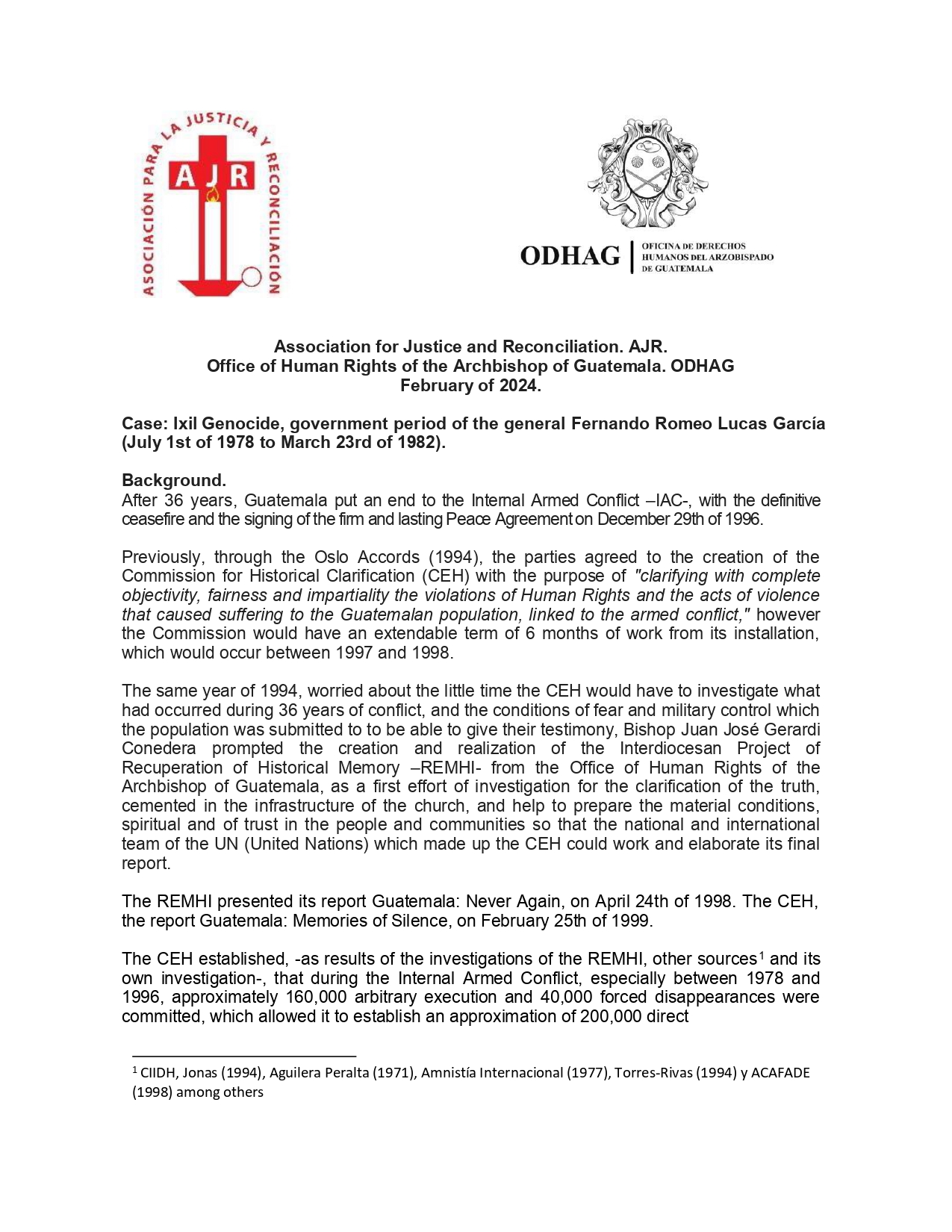

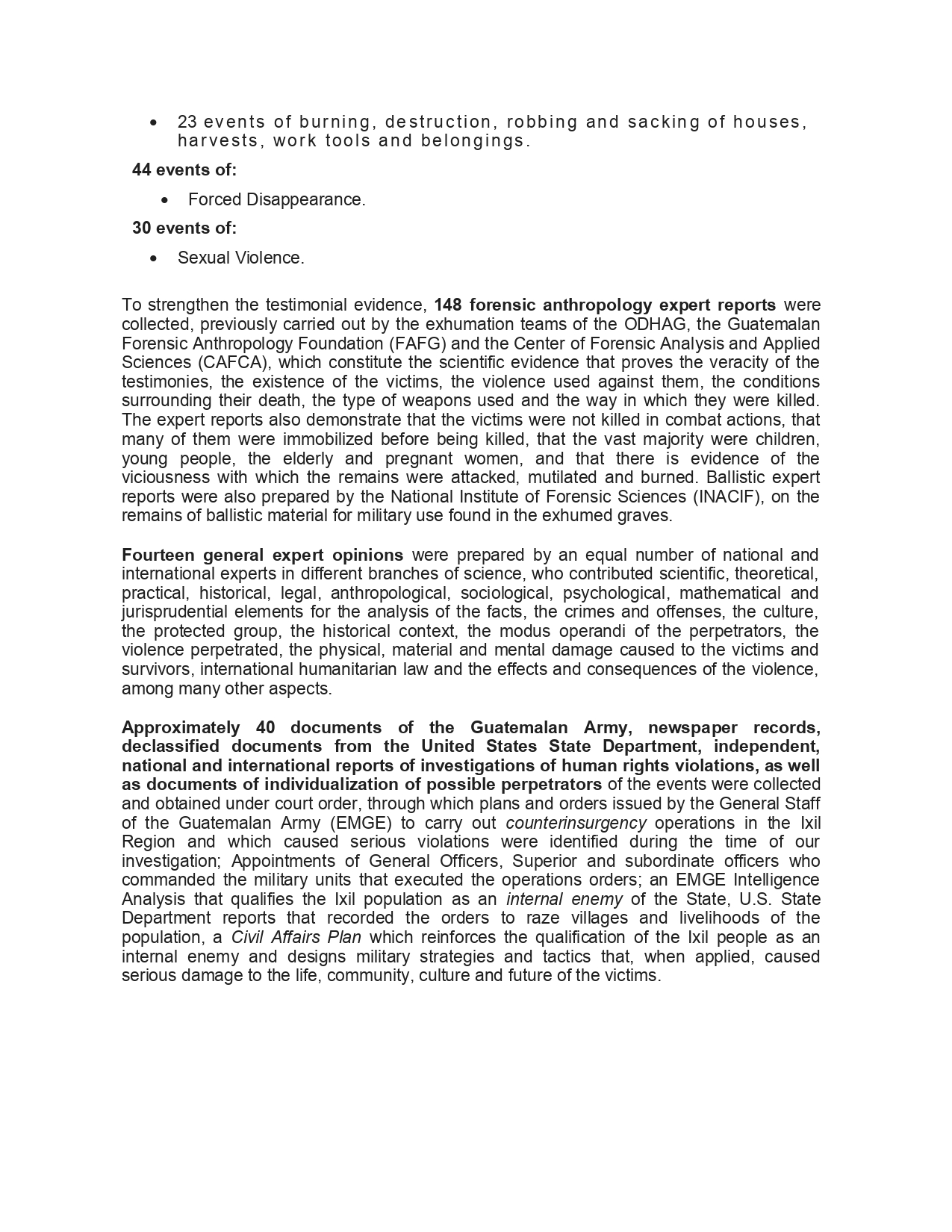
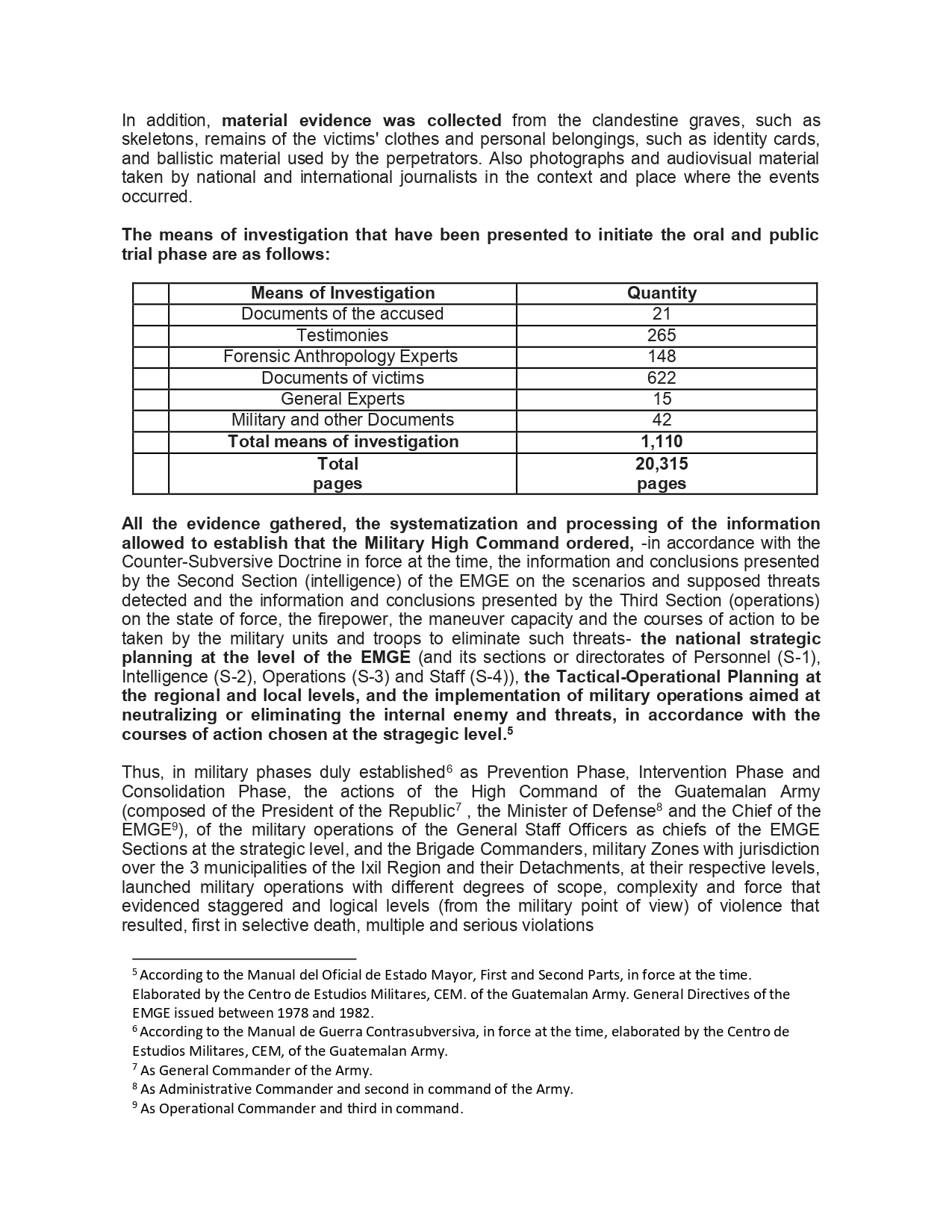
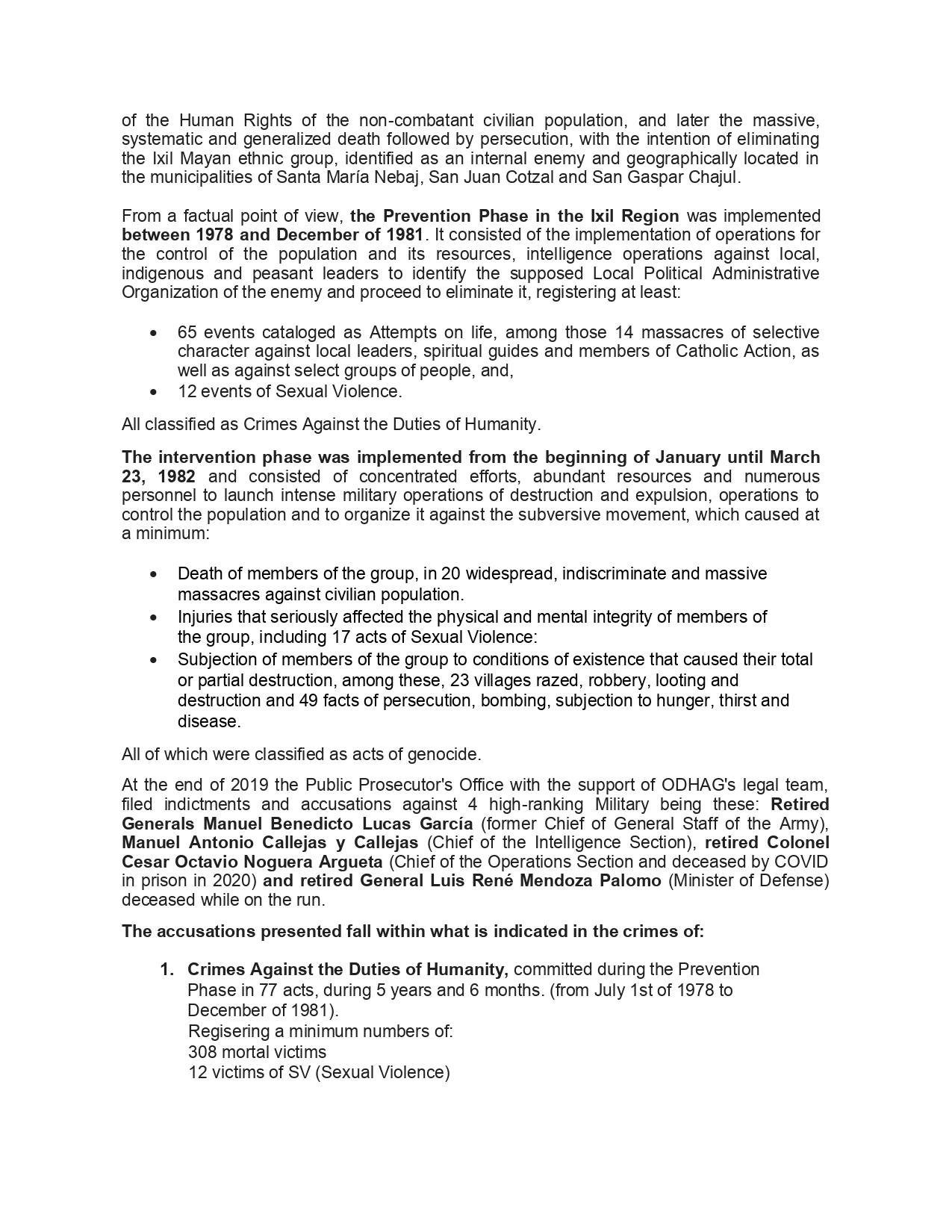
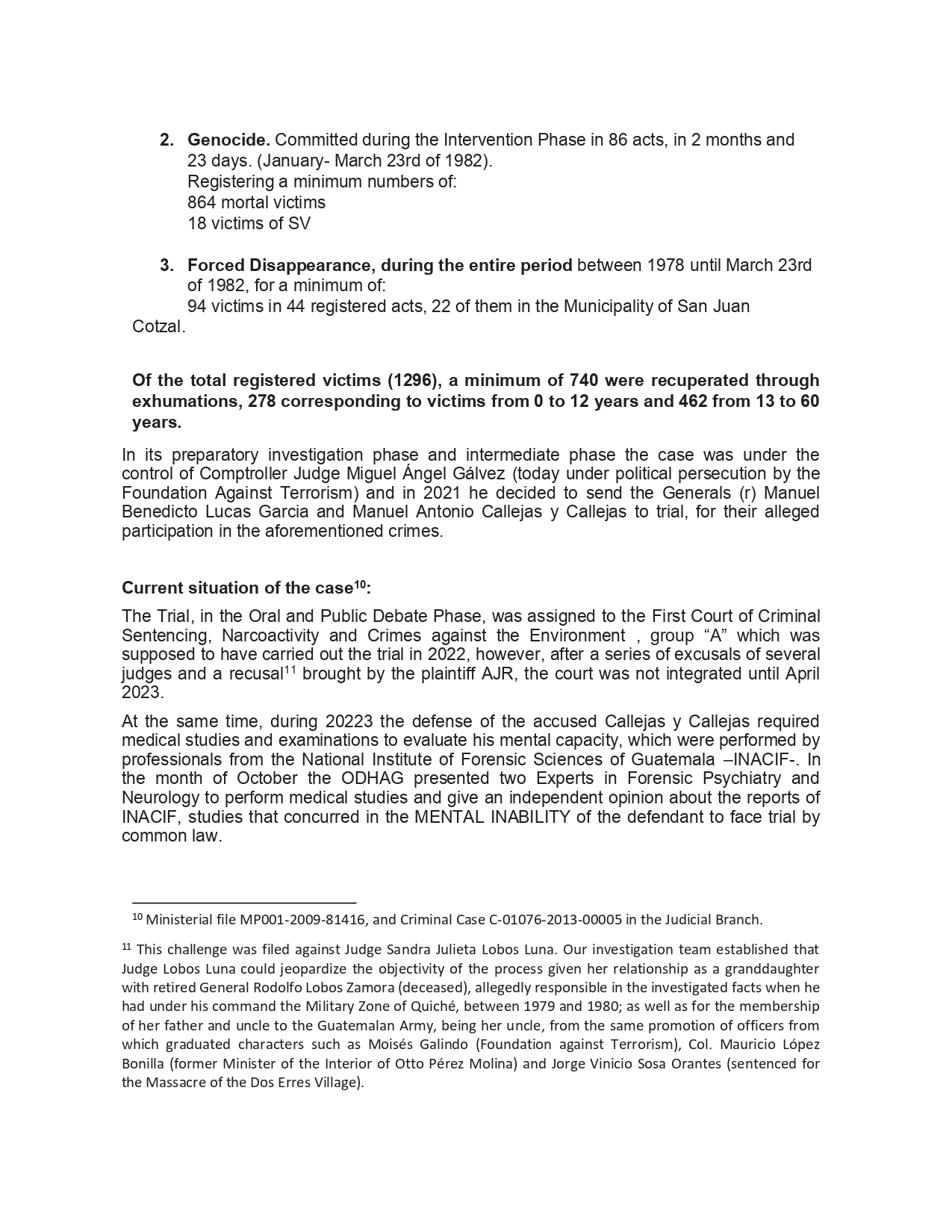
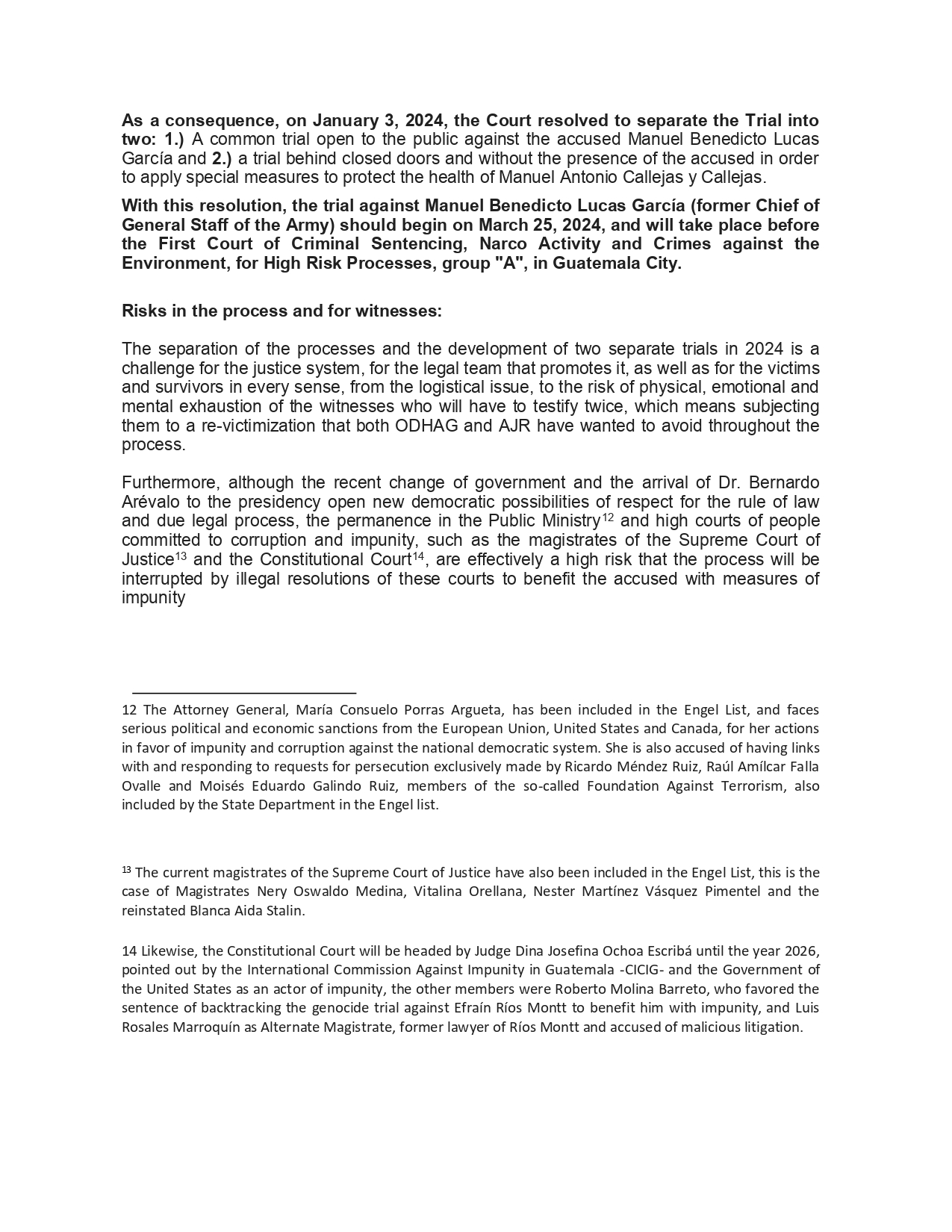
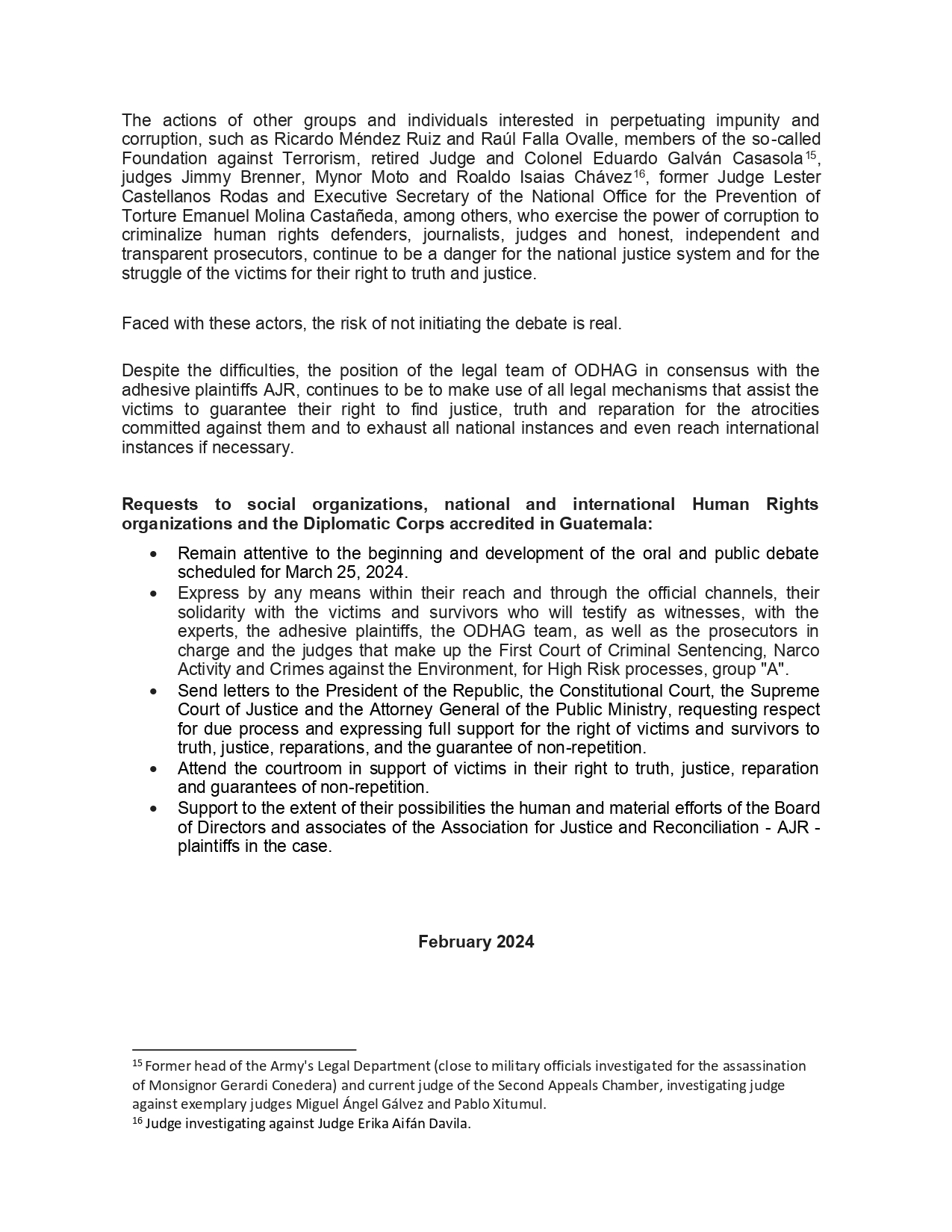
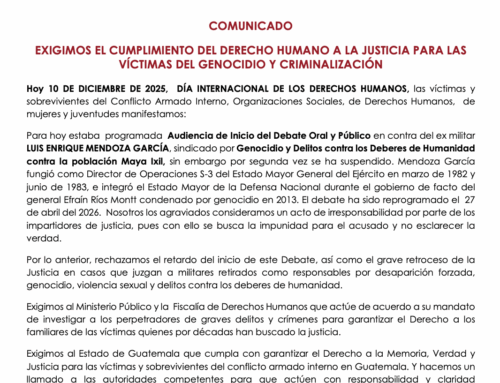
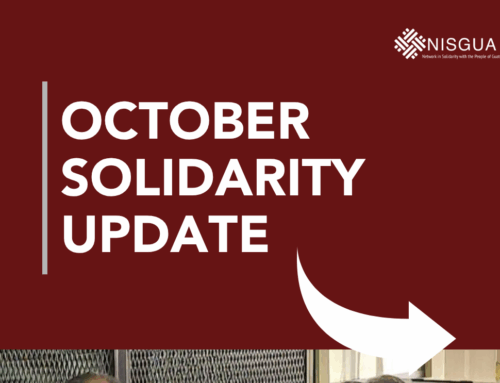
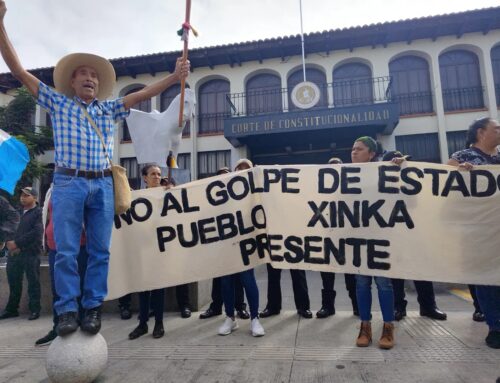
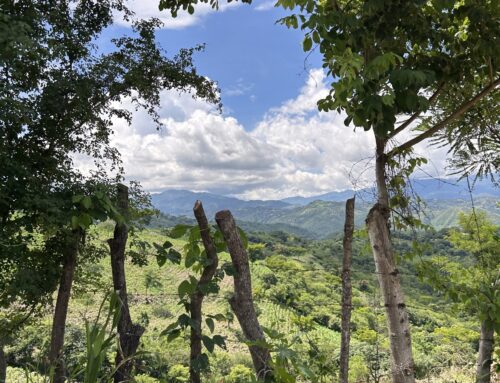
Leave A Comment